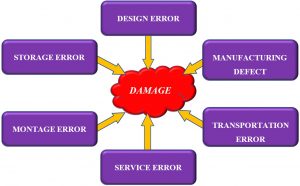 DAMAGE
DAMAGE
Damage can be described as harm (wear, degradation, cracking, deformation, rupture, breakage, etc.) caused by any event that reduces normal functions, usefulness, performance or value expected of a structure. It occurs due to technological errors in design, manufacturing, transportation, storage, installation, service/operation phases.
A structure becomes dysfunctional in the following situations:
- It becomes completely unusable.
- It is available, but it cannot adequately perform the expected performance.
- There is serious damage so it can be dangerous to use.

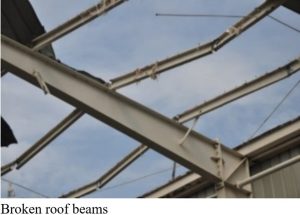

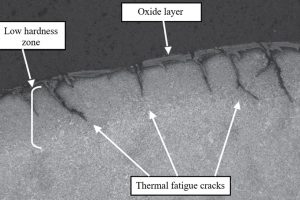
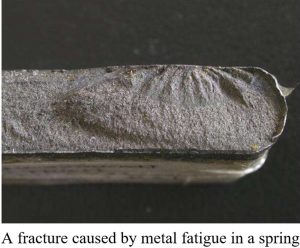 Some important types of damage:
Some important types of damage:
- Errors arising from the production phase (casting, non-metal residue, heat treatment, rolling, incorrect assembly etc.),
- Metal fatigue,
- Creep (high temperature),
- Corrosion damage (general corrosion, stress corrosion cracks),
- Hydrogen embrittlement.


Essentially, it is not possible to completely prevent error occurrence and thus damage. Mechanical, thermal and chemical processes applied to a material can cause microscopic errors. These errors, which do not cause any damage at the beginning, may develop during use and cause a damage. For example, a crack below the critical size can reach a critical size over time and cause damage.
Some types of damage are related to each other. For example, the fatigue life of corroded aluminum alloys can be reduced by 60%.
DAMAGE ANALYSIS
Damage analysis is to determine mechanism and technological error that cause damage by studying the damage with scientific methods, and to develop measures to avoid repetition or postponement. With damage analysis, it will be possible to design structures with less errors that can serve high performance for a long time and to improve the working conditions of these structures.
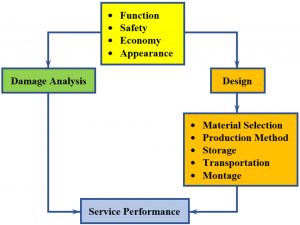 In damage analysis, the damage is examined by considering design, material selection, production method, storage, transportation and assembly and service performance phases and the relationships between them.
In damage analysis, the damage is examined by considering design, material selection, production method, storage, transportation and assembly and service performance phases and the relationships between them.
Some damage analysis:
- Production errors and causes (casting, rolling, heat treatment, welding and other production errors),
- Internal structure problems and their causes in metal and alloys (coarse grain, non-metal residue, micro-cracks, problems caused by overheating),
- Metal fatigue damage and prevention,
- High temperature problems and solution suggestions,
- Corrosion damage and solution caused by the working conditions of the material,
- Hydrogen embrittlement damage and solution,
- Stressed corrosion crack problems,
- Whether a damage is caused by a usage error,
- Damages due to incorrect material selection.
 Errors due to incorrect production / fabrication processes:
Errors due to incorrect production / fabrication processes:
- Defects caused by chemical composition: Fragile elements such as residues, S and P,
- Casting errors: Residues, segregation, porosity,
- Mechanical process errors,
- Machining errors,
- Welding errors,
- Heat treatment errors,
- Surface hardening processes errors,
- Surface preparation process errors,
- Errors arising from anisotropic structure,
- Assembly defects (the most common type of error).
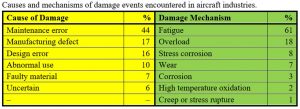
Causes of damage in service conditions:
- Wear,
- Corrosion,
- Maintenance and repair defect (welding, riveting, grinding, drilling, cold deformation etc.),
- Chemical effects in the working environment (effect of liquid metal or acid environment, high temperature coating),
- Radiation effect,
- Abnormal working conditions (abnormal operating temperature, excessive mechanical vibration, sound vibration, impact, thermal shock, etc.).
 These damage mechanisms depend on stress, time, temperature and working environment, and interact with each other. For example, fatigue may occur after a crack caused by wear. For this reason, the following information should be collected to determine the damage mechanisms:
These damage mechanisms depend on stress, time, temperature and working environment, and interact with each other. For example, fatigue may occur after a crack caused by wear. For this reason, the following information should be collected to determine the damage mechanisms:
- Loading type: uniaxial, cyclic or impact,
- Stress type: Tensile, compression, shear,
- Service temperature: Low temperature, high temperature, room temperature,
- Service environment: It affects corrosion rate,
- Service time: It is important for detecting time dependence of damage mechanism.
- Fracture: Brittle, ductile,
- Fatigue: Long-lasting, short-lived,
- Creep: Load amount and temperature,
- Deformation: Elongation, shortening, bending, permanent deformation regions,
- Corrosion: Normal corrosion, stress corrosion, corrosion due to fatigue,
- Wear type.
Stages of Damage Analysis
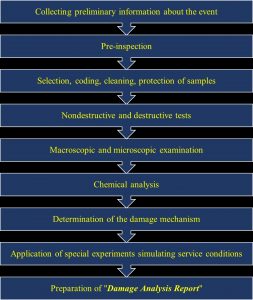
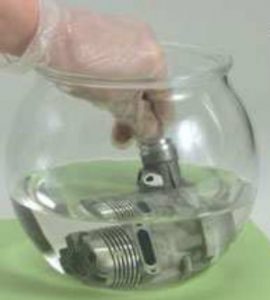
Content of “Damage Analysis Report”:
All the information obtained is recorded in this report:
- Information about the damage incident,
- Service conditions at the time of damage,
- Service records about the history of the damaged part,
- Chemical composition and mechanical properties of the damaged part,
- Mechanical and metallurgical inspection results of the damaged part,
- Determination of cause and mechanism of damage,
- Recommendations for preventing damage.
Teknolab provides damage analysis service with its accredited modern laboratories according to TS EN ISO / IEC 17025 standard equipped with experienced specialist staff and state-of-the-art analytical equipment.
Some our failure and damage analysis services:
- Material assessment: We can provide you with expert failure analysis of every kind of material through mechanical, physical, chemical or micro-structural investigation.
- Corrosion investigation: We can assess and mitigate your corrosion problems and offer the best alloy and/or coating for your needs.
- Fractography: We can characterize the morphology of fracture surfaces in metals, polymers and ceramics, identify the reason for breakage and help you to introduce counteractions.
- Design review: We can provide a systematic, comprehensive and documented analysis of your design.




